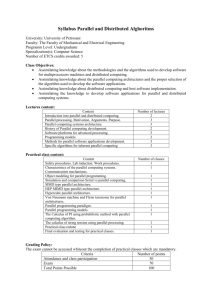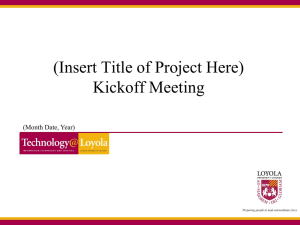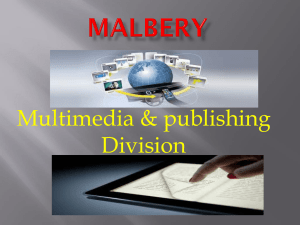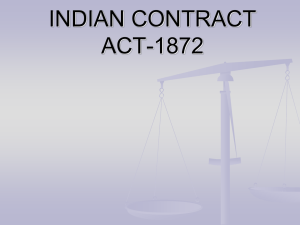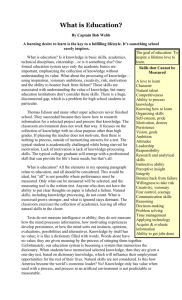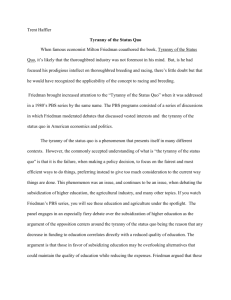Managing Organizational Change, Resistance and Conflict
advertisement
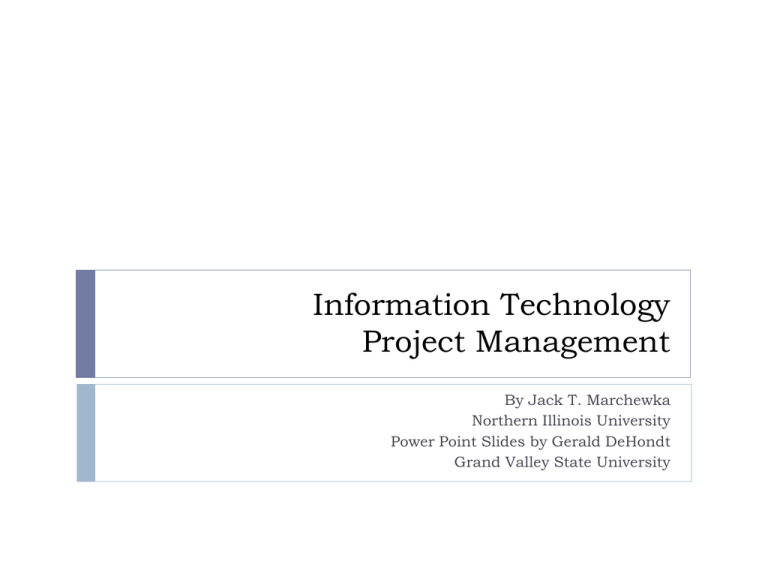
Information Technology Project Management By Jack T. Marchewka Northern Illinois University Power Point Slides by Gerald DeHondt Grand Valley State University Managing Organizational Change, Resistance, & Conflict Chapter 11 11-2 Reactions to Change At any given point in our lives, we all go various changes School Family Personal We have all been through change - but how do we think about and manage it? Dealing with the people issues, or soft side of technology, is an area that most technical people do not enjoy. Many technical people and managers naively believe that the users within the organization will gladly embrace a new system if it is built properly. 11-3 Managers & Technical People May Have The False Beliefs People want this change. Monday morning we’ll turn on the system and they’ll use it. A good training program will answer all of their questions and then they’ll love it. Our people have been through a lot of change – what’s one more change going to matter? We see the need for helping our people adjust, but we had to cut something. They have two choices. They can change or they can leave. 11-4 In Reality, … Some people believe that it is easier to gain compliance than it is to gain acceptance Unfortunately, It assumes that everyone will comply and that compliance is long lasting The change may not occur People will comply for a time and then do things to get around the change Users will accept only a portion of the change And the full benefits of the project (MOV) are never realized or only after a great deal of time and resources are expended 11-5 Change Management Acceptance is much more powerful and longer lasting than compliance This requires that employees be prepared properly before the system is implemented A company going green requires employees to give up individual printers and share printer servers. Losing entitlements can cause resentment. Change management helps smooth the transition and implementation of the new IT solution Defined by the Gartner Group The transforming of the organization so it is aligned with the execution of a chosen corporate business strategy. It is the management of the human element in a large-scale change project. 11-6 The Nature of Change Whether we view change as positive (anticipation) or negative (dread), there is a certain amount of stress that accompanies each change. 11-7 Change has an Impact. Change is a Process. Change is Emotional. Assimilating Change Organizations must deal with change as an individual would and manage within the change threshold Positive (anticipation) or negative (dread) change causes stress and anxiety Assimilation is the process of adapting to change. How long it takes is a function of the impact of the change Not assimilating fast enough or too many changes at once can lead to problems. Managing change is critical. To much change can lead to organizational dysfunction Inability to take advantage of new opportunities Inability to solve current problems Can eventually lead to an inability to make a profit 11-8 Assimilation of change required Assimilating Change Assimilation is the process we use to adjust to positive or negative changes. Problems occur when we have to deal with too many changes or when we can’t assimilate to change fast enough. Change Threshold Time 11-9 Assimilating Change Leavitt’s Model of Organizational Change suggest that changes in people, technology, task or organizational structure can influence or impact other areas The four areas are interdependent – a change in one can result in a change in other areas Implementing a new IT system (technology) can lead to new roles and responsibilities (people) as well as impact the work they perform (tasks) and the structure of the organization (formal or informal) 11-10 Impact of Organizational Change (Leavitt’s Model) People Structure Technology Task 11-11 Change Is a Process Kurt Lewin – Force Field Analysis / Change Theory Help to analyze and understand the forces for and against a particular plan or change initiative FFA – technique for developing a big picture that involves all the forces in favor or against a particular change Driving forces facilitate change Resisting forces act as barriers to change By understanding all these forces, one may enact strategies or decisions that take into account all of the various interests 11-12 Change Is a Process The present state represents the status quo To change from the current state, there must be driving forces to initiate and motivate the change This requires an unfreezing or an altering of the current state’s habits, perceptions and stability (feeling of loss) The transition state or neutral zone can be a limbo or emotional wilderness for many individuals Rushing individuals through the transition results in confusion and the resisting forces (emotional/psychological barriers) tend to push the individuals back to their present state or to escape (leave the organization) Staying too long in the transition state may lead to a compromise and only a portion of the change may be implemented 11-13 Change is a Process Driving Forces Present State Unfreezing Force Field Analysis – Lewin, 1951 11-14 Resisting Forces Transition State Changing Desired State Refreezing New Status Quo Emotional Response to Change Change can also bring out emotional responses An well established equilibrium is upset Five stages of grieving (Elizabeth Kubler-Ross, On Death and Dying) have been applied to handling change Management may be way ahead of others in the stages due to knowing about the change early on. They must have patience to let other reach the same stage. Sense of loss of status quo Acceptance – accept but not necessarily like the change, “deal with it” 11-15 Five Stages of Grieving Denial Anger Attempts to make deals to avoid the change, “we can work things out” Looks for ways to extend the status quo Depression Blaming others for the change - feel anger, don’t act on it Bargaining Shock and disbelief - Are you serious? This can’t be true! Admits that change is inevitable and understands the impact Recognizes loss of the status quo Acceptance Coming to grips with the change, “deals with it” Moving on to the new state 11-16 Emotional Responses to Change active Emotional Response anger acceptance bargaining stability passive denial 11-17 shock testing depression Time Elizabeth Kubler- Ross, 1969 Reactions to Change Change may Be an ending Mean giving something up Be stressful Be easier for those initiating the change Be the basis for resistance and conflict Change the “rules for success” 11-18 Change Management Plan To succeed with change, the key is to plan and manage the change and the associated transition effectively Just creating a change management plan sends a message that management cares about its employees and will take seriously their concerns The project team and sponsor should address and be clear on several important areas 11-19 Change Management Plan 11-20 Assess Willingness, Readiness, and Ability to Change Players involved in change Sponsor Initiating vs. sustaining sponsor A major portion of the organization’s ability and willingness to support the change rests with the sponsor’s commitment to the project and the associated change that will impact the organization Change Agents 11-21 The project manager and team make the change happen Report directly to the plan sponsor Must consider how change impacts the rest of the organization (loss of power, control, relationships) Assess Willingness, Readiness, and Ability to Change Targets of Change The users, customers, etc. Must understand The real impacts of the change The breadth of change What’s over and what’s not Whether the rules for success have changed 11-22 New management now promotes based on performance and not seniority Develop or Adopt a Strategy for Change Rational–Empirical Approach How will change benefit a particular person or group identified as a target of the change Message must be consistent, accurate and timely Saying nothing can send the wrong message Picture – vision as to how the organization will look or operate in the future Purpose, - reason for the change, impact on entire organization (current poor service) Part to Play – involvement in the change, WIIFM (what’s in it for me) 11-23 Develop or Adopt a Strategy for Change Normative-Reeducation Approach Focuses on helping people redefine their existing social norms into a new set that supports the change effort People are social beings and human behavior can be changed by changing the social norms of a group Focus on the core values, beliefs, and established relationships that make up the culture of the group rather than the individual This approach can be very difficult and time consuming because the change agents and sponsor must study the existing values and beliefs of a group 11-24 Need to unfreeze the current norms and set new norms to replace them Develop or Adopt a Strategy for Change Power-Coercive Approach Compliance through the exercise of power, authority, rewards or threat of punishment for nonconformance May lead to employees looking for other employment Others may just wait out the storm and wait for the old ways to return OTOH, the shock may wake up employees to reality and gain their acceptance. When time is of the essence, this approach can work if employees have no other options Environmental-Adaptive Approach Although people may avoid disruption and loss, they can still adapt to change Cortez burned the boats when he heard grumbling from his men – forced to press on Switch word processor over weekend so on Monday everyone is forced to use the new version 11-25 Implement the Change Management Plan and Track Progress Communication Watch out for the rumor mill! Media is important Face to face communication is generally preferable when delivering important or bad news Must flow in both directions. What you don’t say is as important as what you do say! 11-26 Evaluate Experience and Develop Lessons Learned Experiences should be documented and made available to other project teams Overall success of the change management plan should be evaluated Help to determine the effectiveness of the different players or a particular change management strategy 11-27 Best Practices Provide consistent communication and involvement – WIIFM (What’s In It For Me) Determine support needs - where do people go for help and information? Measure and communicate progress (Quick Wins) Build the need for change (“Burning Platform”) Ensure visible, consistent sponsorship Allow the disenchanted to vent Listen, listen, … and listen some more 11-28 Resistance and Conflict Resistance should be anticipated from the outset of the project Resistance can be either overt, in the form of memos, meetings, etc., or covert, in the form of sabotage, foot dragging, politicking, etc. Resistance can arise for many valid reasons. E.g., Response time of the system is too slow or lacks requested features and functionality Resistance due to cultural or behavioral reasons is harder to rationalize, but still can keep a project from reaching its intended goal 11-29 Why Do People Resist Change? People may perceive the change as requiring more time and energy than they are willing to invest. People may feel that a change will mean giving up something that is familiar, comfortable, and predictable. People may be annoyed with the disruption caused by the change, even if they know that it will be beneficial in the long run. People may believe that the change is being imposed on them externally, and their egos will not tolerate being told what to do. People may resist because of the way the decision to change was announced or because it was forced on them. 11-30 Conflict Management Focuses on preventing, managing, or resolving conflicts. It is important to identify potential conflicts as early as possible so that the conflict can be addressed. Although conflict can be positive and help form new ideas and establish commitment, negative conflict left unresolved can lead to damaged relationships, mistrust, unresolved issues, continued stress, dysfunctional behavior, and low productivity and morale. 11-31 Although conflict is one of the things most of us dislike intensely, it is inevitable. Most often when we try to avoid conflict, it will nevertheless seek us out. Some people wrongly hope that conflict will go away if it is ignored. In fact, conflict ignored is more likely to get worse, which can significantly reduce project performance. The best way to reduce conflict is to confront it. (Verma, 1998, p. 367) 11-32 Types of Conflict Traditional View All conflict should be avoided “Why can’t we all just get along?” Contemporary View Conflict is inevitable and natural Positive conflict stimulates ideas “Let’s agree to disagree!” Negative conflict can be damaging Interactionist View Conflict is necessary for performance 11-33 “Devil’s advocate” Stir the pot to encourage positive conflict Tough to manage properly Types of Conflict Verma points out that conflict within projects can fit into one, or a combination, of three categories 1. 2. 3. 34 Conflicts associated with the goals, objectives or specifications of the project Conflicts associated with the administration, management structures or underlying philosophies of the project Conflicts associated with the interpersonal relationships among people based on work ethics, styles, egos or personalities Approaches to Conflict Avoidance Accommodation Retreat, withdraw, or ignore conflict Cooling off period may be a wise move Appease the parties in conflict, may be only useful in the short-term Forcing 11-35 Dominant authority resolves conflict, useful when time critical decision is needed Approaches to Conflict Compromise Involves aspects of forcing and accomodation Bargaining – important aspect of a project may be compromised (e.g., quality standards compromised to meet project schedule) Collaboration Confronting and attempting to solve the problem by incorporating different ideas, viewpoints, and perspectives. Requires time and sincere desire to work out a mutually acceptable solution 11-36 Approach to Conflict Situation Each conflict situation is unique and the choice of an approach to resolve conflict depends on: Type of conflict and its relative importance to the project. Time pressure to resolve the conflict. Position of power or authority of the parties involved. Whether the emphasis is on maintaining the goals, objectives of the project or maintaining relationships. 11-37
